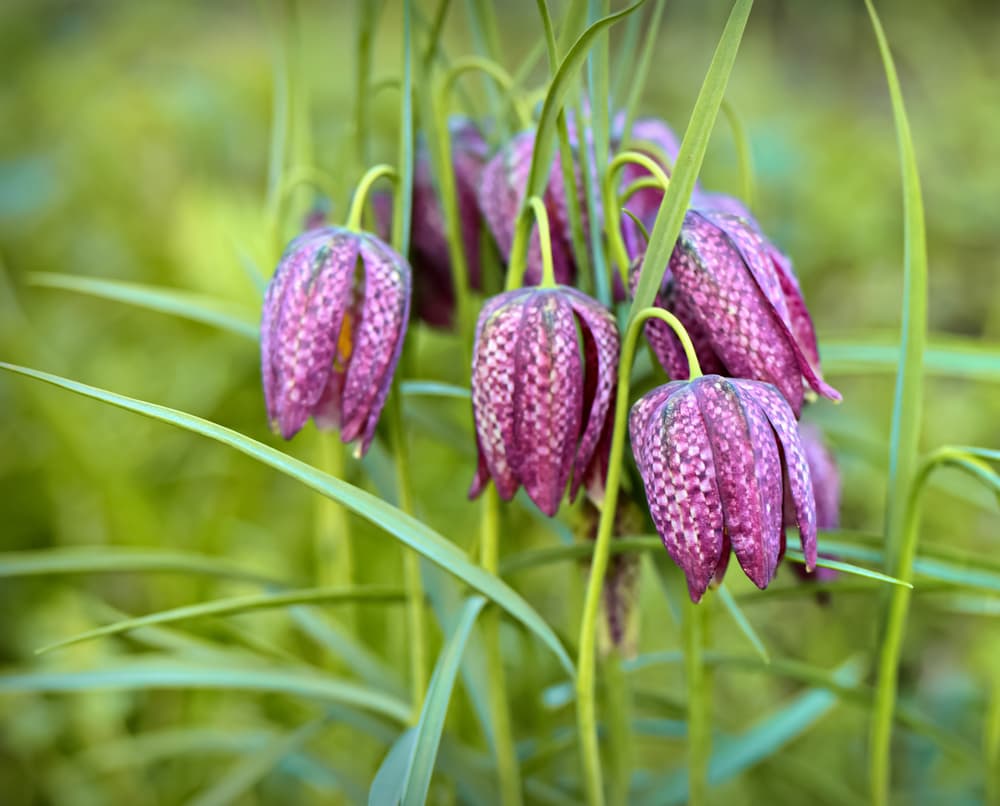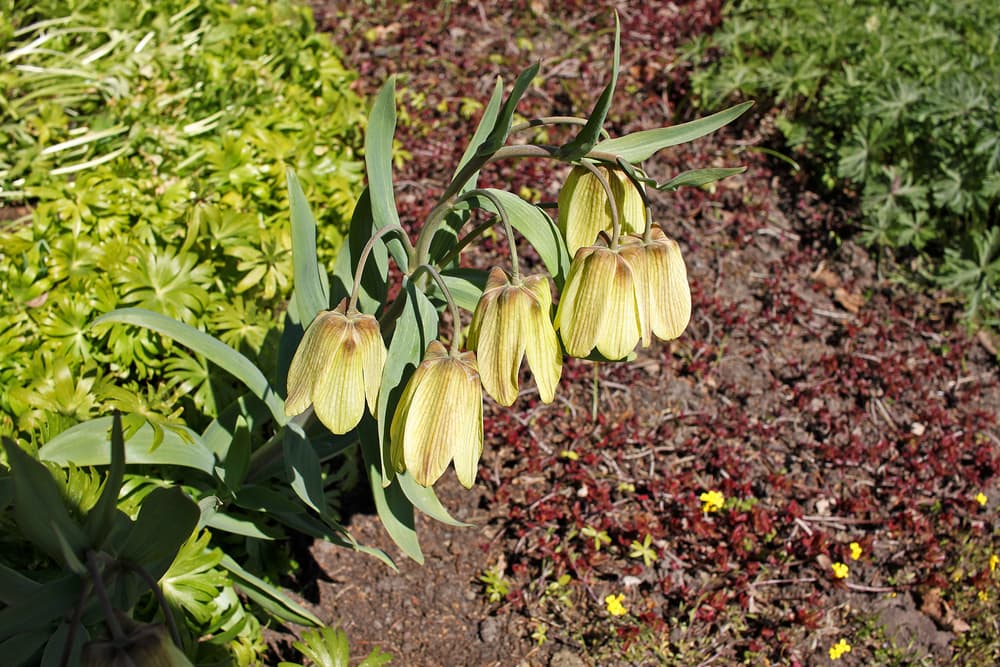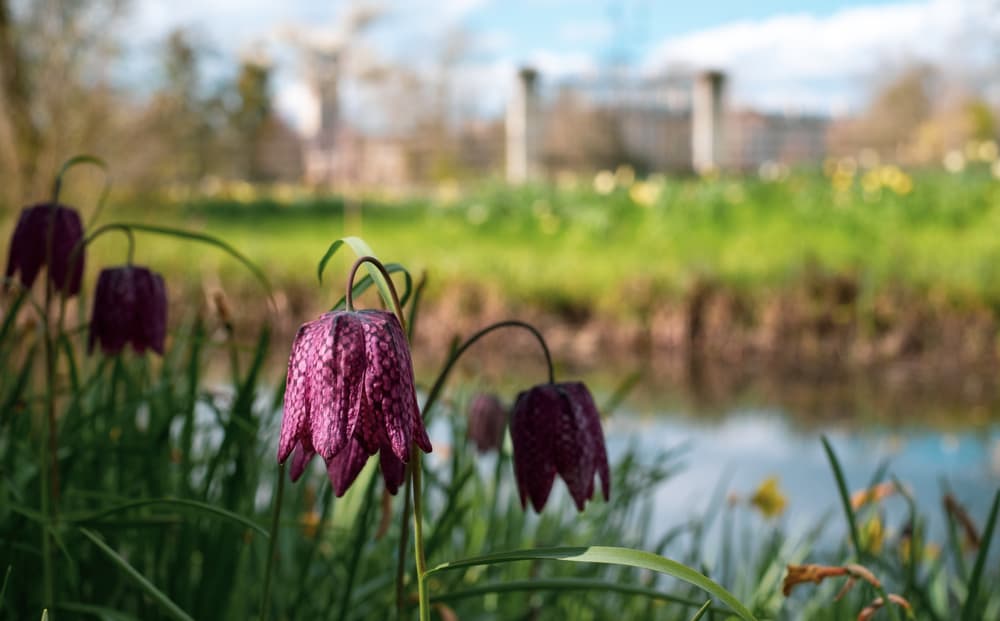BULBS > FRITILLARIES
Chris is a gardening writer and nature enthusiast. He graduated from Oxford Brookes University in 2022 with an MA in Psychology. Chris works with the Leeds Green Action Society, helping their food cooperative by growing various fruit and vegetables on their two allotments in Hyde Park, Leeds.
Reviewed By PETER LICKORISH

Peter is a Horticulture Lecturer and self-employed Horticulturist, with a passion for diverse areas of the industry - from garden design to the science behind plant growth and propagation. He has completed the Royal Horticultural Society’s Master of Horticulture (MHort) Award and lectures on RHS courses at Bedford College.
Contributions From DR. ROBERT WALLIS

Dr. Robert Wallis is the Chairman of The Fritillaria Group and an avid grower of fritillaries and other small bulbous plants.
IN THIS GUIDE
FRITILLARY GUIDES
If you’re looking for an attractive plant with an impressive CV, consider fritillaries.
Boasting lilting lantern-like flowers, fritillaries are closely related to lilies and have a long history of use in ornamental gardening and horticultural settings.
They bring an undeniably exotic feel to any garden, and most varieties allude to oriental shapes and themes.
In the course of producing this guide I contacted Dr Robert Wallis, Chairman of The Fritillaria Group.
He shared just why these plants are so popular and well-loved in the UK.
“The genus Fritillaria contains around 180 different species from many different habitats around the world.
“Most grow in Mediterranean climates at varying altitudes, whilst some are semi-desert plants.

“Others come from more northerly places and adapt well to life in [the] UK”.
Though originally hailing from Europe and Asia, British gardeners have been familiar with fritillaries for several hundred years.1Fritillaria meleagris. (n.d.). Kew Royal Botanic Gardens. Retrieved March 16, 2023, from https://powo.science.kew.org/taxon/urn:lsid:ipni.org:names:535213-1
Looking at the plant, it’s easy to see how they made a good first impression, and how they’ve endured centuries of evolving trends and fashions.
Incorporating fritillaries into your garden is a way to bring genuine beauty, while giving a nod to their proud cultural and historical background.
Overview
| Botanical Name | Fritillaria species |
| Common Name(s) | Crown Imperials, Snake’s Head |
| Plant Type | Bulb / Perennial Flower |
| Native Area | Europe & Asia |
| Hardiness Rating | H4-H7 |
| Foliage | Deciduous |
| Flowers | Nodding bowl / bell-shaped flowers |
| When To Sow | September, October |
| Flowering Months | April, May |
Sunlight
Preferred
Full Sun / Partial Shade
Exposure
Exposed or Sheltered
Size
Height
0.1 – 1M (depending on species)
Spread
0 – 0.1M
Bloom Time
April – May
Soil
Preferred
Chalk, loam, sand
Moisture
Well drained to moist, depending on species
pH
Any
Fritillaria meleagris is considered to be the type species of the Fritillaria genus, which in non-jargon terms means that this is the variety most indicative of the appearance and characteristics of related plants.
In the image below, you can see the bowing stem of F. meleagris – also called snake’s head – with its iconic flower resembling a bell or lantern.

In most varieties the flowers are solitary, making them all the more visually impressive.
The mottling on the petals offers visual interest distinct from other flowers with single-colour petals, and this subtle aspect can be used to great effect when designing flower beds.
“The species name F. meleagris matches the scientific name of turkeys and guinea fowls, and there is something akin to their feathers in the plant’s petals,” adds Master Horticulturist Peter Lickorish.
Fritillary Types
“There are a few species which are easy in the garden”, says Robert.
“Others are more exacting in their requirements and present various degrees of challenge to grow successfully”.
For those growing Fritillarias for the first time, Robert suggests: “start with the easy (cheap!) ones like F. meleagris and F. imperialis for the garden but be aware that Fritillaria is a large genus and the species have widely differing requirements for successful cultivation”.
Below we share a selection particularly well-suited to British gardens – each a recipient of the RHS Award of Garden Merit.
Snake’s Head Fritillary

Botanical Name: F. meleagris
This species is an easy-to-grow favourite, says Robert: “Fritillaria meleagris is a beautiful and easy species in the garden. Unlike most species, it revels in moist soil, particularly in a meadow situation.”
The delicate purple flowers of this variety capture the aesthetic and atmosphere you can expect from other varieties: the colour and petal pattern may change between varieties, but the bowing appearance and gentle confidence remains.
This variety enjoys full sun or partial shade and moist, well-drained soil. It isn’t fussy with aspect, exposure, soil type, or soil acidity.
Siberian Fritillary

Botanical Name: F. pallidiflora
This variety boasts creamy flowers, bunched together a bit more tightly than the meleagris, hinting at the varied aesthetics centred on the common fritillary theme.
White and pale flowers are an ever-popular feature in flower beds and plant displays, meaning the Siberian plant should be right at home in many contexts.
The preferred growing conditions are the same as those for F. meleagris.
Crown Imperial

Botanical Name: F. imperialis
Tussles of orangey flowers hanging below a crown of green leaves almost bring to mind a pineapple, which isn’t something that can be said about many flowers.
For this reason, F. imperialis makes a quirky and striking contribution to any outdoor space, especially if you’re riffing on exotic themes.
The crown imperial like full sun and well-drained soil, alluding to the different conditions preferred between Fritillaria varieties.
Pointed-Petal Fritillary

Botanical Name: F. acmopetala
The petal frond framing a brownish purple central section almost resembles the shape of a model boasting a 1960s haircut.
However you perceive the form and colour of this flower, though, you can’t deny that it makes an attractive addition to any flower arrangement with whites, browns, oranges, or yellow.
This variety shares growing preferences with the crown imperial.
Other favourites grown by Dr. Robert Wallis include:
- F. gibbosa – “A semi-desert species from Iran. It has fabulous pink outward-facing flowers. It only needs water from December to March otherwise it is kept dry in the greenhouse.”
- F. obliqua – “Has lovely black flowers. It hails from cool situations in Greece and enjoys a decidedly Mediterranean moist winter and dry summer. It is still necessary to keep it cool in summer though.
How To Grow Fritillaries
Preferred growing conditions vary across the different types of fritillaria, so make sure to check the specific requirements of the variety you’re planning to grow.
The information in the following sections is given as a general guide.
Where To Grow
In the varieties introduced above, we saw that some (snake’s head and Siberian) can make do with partial shade or moist soil, while others (crown imperial and pointed-petal) require full sunlight and well-drained soil.
For this reason, you’ll need to research the preferences of the varieties you’re planning to plant to ensure that each can thrive.
In general, fritillaries are less fussy with soil type and pH than exposure, aspect, moisture levels, and hardiness.

On the last point, hardiness ratings in the varieties above range from H4 (suitable to temperatures of around -10°C) to H7 (suitable below -20°C).
If you live in particularly cold parts of the UK, double-check that your planned fritillary can handle the expected temperatures.
“Each year I really hope to see birds feeding from the nectar of the crown imperial fritillary,” says Peter.
“It is well documented that small birds, such as blue tits, will perch on the stems and lift their heads into the flowers, but I’m yet to see it. A good excuse to plant more, I suppose!”
Planting
You’ll want to plant your tall crown fritillary bulbs about 30cm below the soil surface, in September or October, whereas lower-growing snake’s head bulbs can go in at 5-8cm deep.
The general rule when planting bulbs is to plant them with the tip facing up or, if it’s unclear which bit is the tip, plant them on their sides.
They’ll struggle to grow if planted tip-down.
Fritillary Plant Care
Feeding
You can feed fritillaries each spring, with a fertiliser that releases nutrients slowly – potash is one option.
Avoid using fertilisers high in nitrogen, as this carries the risk of encouraging surrounding grasses to grow, rather than your flowers.
Watering
Water well after planting your bulbs, as moist soil conditions will encourage healthy growth.

Fritillaries don’t need too much watering when in bloom – just be vigilant during especially dry periods.
Pruning
You don’t need to prune any variety of fritillaries – hallelujah! We told you they were easy to grow.
Propagating
Your plants will produce ‘offsets’ each year, which are baby bulbs.
You can dig these up by carefully separating them from the parent bulb.
Either plant the offset elsewhere, leaving enough space between plants to avoid overcrowding, or give them to a friend to spread the fritillary love.
Common Problems
This flower isn’t prone to any nasty plant diseases, which is another tick in the ‘easy to grow’ box.
Aside from a few sneaky pests who may try to feast on their alluring petals and stems, fritillaries most likely won’t encounter many problems.

Slugs & Snails
It feels like we write a slugs and snails section in almost every plant care & growing guide we publish.
These guys are relentless, and their quest to feast on your lovingly-tended flowers is unceasing.
But thankfully, there are a few ways to keep them at bay.
Lily Beetles
Fritillaries are also prone to lily beetles, because of their similarity to the flower.
These pests lay their eggs on leaf undersides, which then hatch, releasing lots of hungry larvae to feast upon leaves, leaving a trail of unsightly excrement in their wake.
“Both the adult and larvae of the striking red Lily Beetle likes to eat fritillary leaves” says Robert.
“They are best captured and squashed.”
The first step is to remove beetles and their eggs by hand, before they hatch and begin to wreak havoc.

You can also encourage predatorial wildlife to visit your garden, which will eat the beetles and keep their populations in check.
“Lily beetle will even eat the flowers, so try to manage this pest,” says Peter.
“I find cupping a hand underneath the stem and knocking them into it stops them from pulling off their favourite trick of dropping onto soil and lying upside down.
“If they do this, they become almost invisible.”
These unfussy and attractive plants are a pleasure to grow, and will delight anyone who steps foot in your garden.
References
- 1Fritillaria meleagris. (n.d.). Kew Royal Botanic Gardens. Retrieved March 16, 2023, from https://powo.science.kew.org/taxon/urn:lsid:ipni.org:names:535213-1

